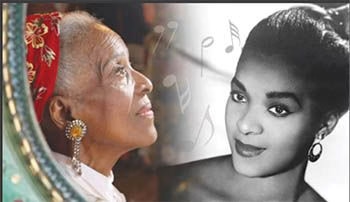Singer Hope Foye from Red Hope? The Black Listing of Hope Foye, a film by Constance Jackson.
Watch it at Permproductions.com
In 1998, Random Lengths ran a profile on barrier breaker and opera singer, Hope Foye. At the time, she had been a 20-year San Pedro resident in South Shores.
For herself, others for her, and she for those who would follow –Hope Foye’s life and career as a People’s Artist has been about opening doors.
Foye’s career includes performances with international star and civil rights activist Paul Robeson, the host of her radio program, and top billing on the marquee at the world’s greatest concert halls, from Zurich to Mexico and from Berlin to Tel Aviv.
Foye had grown up a foster child in the home of an African American seminarian in Harford, Connecticut, where her spectacular voice and skin color set her apart. In her early years, she received a full scholarship from the Young Hadassah Women’s Club to the prestigious Hartt School at the University of Hartford, Connecticut. “I didn’t believe I’d have a chance, being black, and I was the only black who competed… and I was the winner,” she said.
Her political education began in 1941 when the sons and daughter of her foster parents talked her into joining a pilgrimage for peace, though her own sweetheart had just enlisted to fight in World War II.
“I was the only Black woman at the time when we left Connecticut,” says Foye, “but when we got to New York, a man and a woman joined us. Everyone else was white and we had signs about the brother of men, getting rid of the poll tax… no more lynching. We started at 136th Street at the YWCA in Harlem and we walked to Washington, D.C. It took us about 14 days. I looked like an ink spot in milk by the time we got there… because it was summer.” Though they were given shelter by the Quakers and clothes along the way, the journey was not without incident.
“Well, it got scary when we got down to Maryland,” she remembers, “Where they attacked us and tore up our signs and they threatened us with broken bottles. There was only one Black guy there and me and everybody else was white. There weren’t many of us. It wasn’t like Martin Luther King’s march on Washington, but I’ll tell you what, it was the first march on Washington.”
For her activism, Foye would later be called to testify before the House Un-American Activities Committee (HUAC) in the 1950s. The HUAC, led by Senator Joseph McCarthy, was infamous for investigating alleged communist sympathies and subversive activities during the Cold War. And she was blacklisted like many others for her political beliefs.
Foye, who was politically active and a member of various progressive and civil rights organizations, was questioned about her associations and political views during a time when many artists, activists, and public figures were targeted for their involvement in left-wing causes and were pressured to provide names of others involved in what the government deemed “un-American” activities. Foye refused.
Hope Foye died on January 6, 2025, at the age of 103, surrounded by family and friends in Las Vegas.
She is survived by daughters Melody Wooly and Datri Kory and a host of grandchildren and great-grandchildren.



